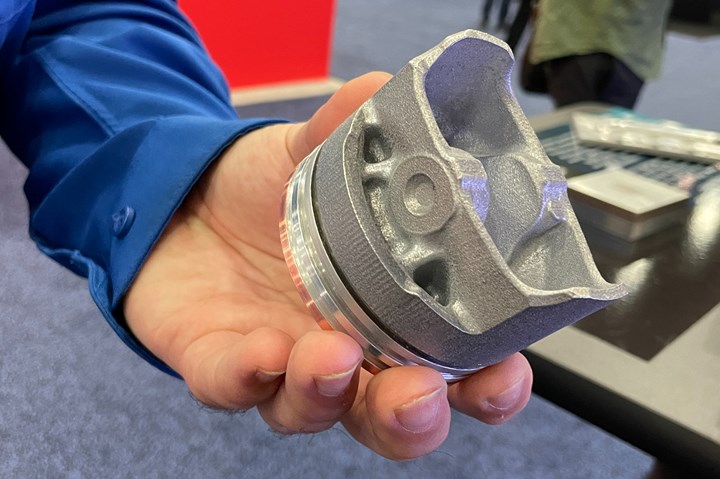Ultrasonic Additive Manufacturing (UAM) Cooperates with Other Processes
Fabrisonic showcases UAM paired with conventional and other additive processes in Booth 433017.
Share




This piston features a copper and stainless steel UAM 3D printed base; laser powder bed fusion was used to build the more intricate features on top. See this and other examples of ultrasonic additive manufacturing in Booth 433017.
The term “hybrid manufacturing” has generally come to mean “additive manufacturing paired with machining in the same machine,” but that definition might be too narrow. From Fabrisonic’s perspective, AM can be combined with other manufacturing processes in many ways, and the company’s booth in this year’s Additive Manufacturing Pavilion illustrates several potential applications.
Fabrisonic provides and produces parts with ultrasonic additive manufacturing (UAM) technology. UAM vibrates very thin sheets of metal together until they fuse, allowing for dissimilar metals to be combined and layered. The process generates very little heat, making it possible to embed electronics, fiber optics, sensors and other components inside these prints.
Parts on display in the booth illustrate how ultrasonic additive manufacturing can be used in combination with other processes to provide specific benefits. A conventional piece of sheet metal with a UAM rib shows one way the process can augment off-the-shelf materials — in this case, adding strength to a thin sheet just where needed, essentially creating a tailor-welded blank through an automated process. UAM can even be combined with other 3D printing processes; the engine piston shown here features a UAM base with layers of stainless steel and copper (for cooling) that was then used as a build plate so that laser powder bed fusion could add the more detailed features on top.
Related Content
-
Tsugami Lathe, Vertical Machining Center Boost Machining Efficiency
IMTS 2024: Tsugami America showcases a multifunction sliding headstock lathe with a B-axis tool spindle, as well as a universal vertical machining center for rapid facing, drilling and tapping.
-
SMW Autoblok Workholding, Automation Solutions Optimize Milling, Grinding Operations
IMTS 2024: SMW Autoblok presents the WPS XL for milling, measuring and grinding operations with five-axis and large part workpieces, as well as several products from its electronics and automation line.
-
FANUC Details Robotic Vision, ROBODRILLS and More at IMTS 2024
FANUC’s IMTS 2024 booth includes real-time demonstrations that show the abilities of its equipment, including robots, controllers and machine tools.

.jpg;width=70;height=70;mode=crop)










